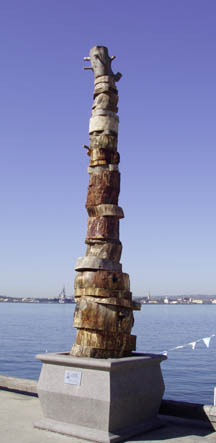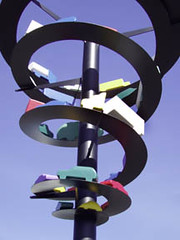
"Let me tell you my story," by Terri Hughes-Oelrich and Anna Stump
Urban Trees2, the Port of San Diego's newest public art installation, opened on March 13 along the city's waterfront. This year 30 artists were commissioned to design, fabricate and install unique "tree" sculptures that would line the Embarcadero, the city's historic harbor district. In many ways this project demonstrates the city's struggle with public art—on the one hand making it possible for public art to be installed throughout the city and tideland areas, and on the other rejecting art's core values that would make a rich artistic heritage possible.
THE TREES
The Port did several things right with its Urban Trees project. First—it recognized how San Diegans and tourists use this city and used this information to create a project that would achieve maximum exposure for the new art works. San Diegans enjoy being out of doors in what is one of the world’s most benign climates; strolling, exercising, shopping and, with today’s technology, even working. At the opening of the project, hundreds of residents and visitors walked the length of the Embarcadero viewing the public art pieces along the way, photographing themselves next to their favorites, and sharing their likes and dislikes with other viewers.
Second—the Port created a bridge between artist and viewer. At the opening of the "exhibition" the artists were set up in front of their pieces where they were able to talk to viewers about the work. In an era in which artists are viewed collectively with suspicion, if not outright hostility, the opportunity to break through stereotypes was a significant strategic move. Viewers and artists engaged in dialogue about the work; and individuals and families were heard continuing that discussion on their own.

"Treeway," by James A. Christiansen
Third—there were enough works commissioned to create a significant visual intervention along the waterfront. With thirty works on view it was a de facto open-air museum. Since the works were sited in a familiar outdoor space there was no implication that the viewer was in a sacred space where only the secret society members understood what was going on. Instead, the waterfront was enlivened and re-imagined with the significant addition and placement of new monuments among familiar landmarks.
Fourth—the Port put together a catalog and map of the works, and actively distributed it to the public in two locations. With this tool the public got both a macro and micro sense of the project, and was supported with information on the art works that helped them understand the work and the intent of the artist. The Port also created a "treasure hunt" style game to encourage people to view the entire collection.
Finally, the Port added additional informational and commercial booths that lent the feeling of a street fair, again adopting the frame of the recreational activities that engage San Diegans.
THE FOREST
With all that is right with Urban Trees2, this viewer left wishing it was more—more about taking chances with the ideas; more about using the sites more evocatively; more about "the ground of experience;" more about challenging the viewer instead of lulling her or him with something merely "pretty;" more about the San Diego that lies above, on and below the surface.
The brilliant psychoanalyst and artist, Rollo May, has written, "(Modern art) has little or nothing to do with prettiness or niceness or sweetness. In its beauty there is the terror of the ground forms, and the contemporary artists are our 'distant early warning mechanism.' They tell us of the fundamentals of love and the terror of life and death." In its Urban Trees program the Port confuses beauty—the core of art— with what is merely pretty.
Good curatorship would have gone far to include works that captured that sense of beauty that Friedrich von Schiller refers to as "the sphere of unfettered contemplation and reflection. Beauty conducts us into the world of ideas, without however taking us from the world of sense." Few of the works in the project rise to that level, even though all are technically sound and well crafted.
I have singled out Let me tell you my story by Terri Hughes-Oelrigh and Anna Stump, and Treeway by James Christiansen (both shown above) as works that DO, in fact, allow the viewer to enter into a realm of ideas that operate on more than one level. They are evocative, surprising, and penetrate our subconscious, allowing us to touch that real experience of knowledge that exists apart from words. We access that non-verbal experience through the arts and through nature, and it is essential to our well-being as individuals and as a society.
Let me tell you my story is composed of sections of once-living trees stacked one atop another like a stack of coins or blocks. It is strongly suggestive of indigenous totem poles. Here the discreet sections, or slices, function like story blocks. There is text scratched into each one and the narrative voice is that of the tree itself. Each one tells of its life and death and the great Cedar fire that destroyed so much of the native (and non-native) trees of San Diego County in 2003. This tree is constructed of many trees damaged by that fire, and the cumulative effect is an echo of voices straining to reach us from across a vanished, and vanishing, landscape. The work is an elegy—both beautiful and deeply sad.
Treeway, on the other hand, delightfully plugs into contemporary experiences of congested urban freeways. Wonderfully crafted, toylike cars and trucks careen down spiraling freeway "branches." They appear to be going down the drain in a whirlpool motion. San Diegans spend so much time in their cars, stuck in traffic and going nowhere, that the identification is immediate. We recognize our absurd situation (the "aha!" moment) in coming upon this work and we laugh—both out of delight and deep recognition of the stress and frustration of our daily, smog-choking, and seemingly unreversible ritual. And as our natural environment—our chapparal, riparian forests and desert—disappears under the asphalt and our cars, it is bitingly ironic that this "tree" comes to grow in a new kind of landscape.
Strong as both pieces are, they would resonate more deeply in a setting that acted in concert with them, extending their meaning even further.
Today good curatorship is at odds with political anxieties about "creating controversy" in civic society. Again, Rollo May writes, "The artist's job is not to comfort, nor even to inform and instruct. The artist's purpose is to liberate, to cleanse the creative process of those rationalized accretions which we invent in order to shield ourselves from the powerful truth of authentic symbols." And yet, the arts agency's directive to produce work that comforts or educates is the roadblock to a great art program. It demands acquiesence from the artist instead of truth. The result of this kind of policy may be more "objects" dotting the landscape, but very little in the way of art.
The Port would be better served if it rethinks how future works should be sited. The best public art takes into account its site and its surroundings. It allows the site to play a role in the meaning of the world. The unrelenting linear nature of the placement of the works sabotages the ability of the artist to use the waterfront as a collaborating element. What if some of the works were on the old pylons, on boats that came and went, on the historic ships that lay at anchor, on top of buildings, below a pier? Might that not open up possibilities to create richer, more fundamental works, and to reframe the existing monuments in such a way that they, too, become more evocative. What we need is a liberation from the visual clutter that dominates our lives.
We need to move from what is pretty and passive, to what is beautiful and awakening.
In moving toward a widespread policy of art in public places we must not lose sight of the forest for the trees.
Quotes attributed to Rollo May come from his seminal book, My Quest for Beauty.